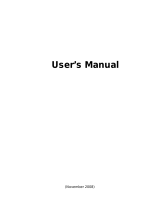
ii
Inserting and Removing a Disc ........................................ 2-15
Using the Network Features ................................................ 2-17
Using the Modem ............................................................. 2-17
Using the LAN ................................................................... 2-18
Using the Wireless LAN .................................................... 2-18
Using the Bluetooth Feature ................................................ 2-21
Turning On/Off the Bluetooth Radio .............................. 2-21
Connecting to another Bluetooth Device ....................... 2-22
Using the WWAN Feature (Optional) .................................. 2-24
Installing a SIM Card ......................................................... 2-25
Turning On/Off the WWAN Radio .................................. 2-27
Using the Fingerprint Scanner ............................................. 2-28
Chapter 3 Managing Power ............................................................... 3-1
AC Adapter .............................................................................. 3-2
Battery Pack ............................................................................. 3-3
Charging the Battery Pack ................................................. 3-3
Initializing the Battery Pack ............................................... 3-4
Checking the Battery Level ................................................ 3-5
Replacing the Battery Pack ................................................ 3-6
Battery Low Signals and Actions ....................................... 3-7
Power Management ............................................................... 3-8
Hibernation ......................................................................... 3-9
Power-Saving Tips ................................................................. 3-10
Chapter 4 Expanding Your Computer ............................................... 4-1
Connecting a VGA or HDMI Display Monitor ....................... 4-2
Connecting a Serial Device ..................................................... 4-4
Connecting a USB Device ....................................................... 4-5
Connecting an eSATA Device ................................................. 4-6
Connecting an IEEE 1394 Device ............................................ 4-7
Connecting Audio Devices ..................................................... 4-8
Using Smart Cards ................................................................... 4-9
Using PC Cards ....................................................................... 4-10
Using ExpressCards (Optional) ............................................. 4-12
Using the MMC/SD Card Reader .......................................... 4-14
System Memory Upgrade ..................................................... 4-16




















